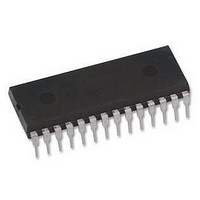DSPIC30F2010-30I/SPG Microchip Technology, DSPIC30F2010-30I/SPG Datasheet - Page 25

DSPIC30F2010-30I/SPG
Manufacturer Part Number
DSPIC30F2010-30I/SPG
Description
16BIT 30MIPS DSPIC, 30F2010, DIP28
Manufacturer
Microchip Technology
Series
DsPIC30Fr
Datasheet
1.DSPIC30F2010-30ISPG.pdf
(244 pages)
Specifications of DSPIC30F2010-30I/SPG
Core Frequency
30MHz
Embedded Interface Type
I2C, SPI, UART
No. Of I/o's
20
Flash Memory Size
12KB
Supply Voltage Range
2.5V To 5.5V
Operating Temperature Range
-40°C To
Lead Free Status / RoHS Status
Lead free / RoHS Compliant
- Current page: 25 of 244
- Download datasheet (7Mb)
2.4
The dsPIC devices feature a 16/16-bit signed fractional
divide operation, as well as 32/16-bit and 16/16-bit
signed and unsigned integer divide operations, in the
form of single instruction iterative divides. The following
instructions and data sizes are supported:
1.
2.
3.
4.
5.
The 16/16 divides are similar to the 32/16 (same number
of iterations), but the dividend is either zero-extended or
sign-extended during the first iteration.
The quotient for all divide instructions is stored in W0,
and the remainder in W1. DIV and DIVF can specify any
W register for both the 16-bit dividend and divisor. All
other divides can specify any W register for the 16-bit
divisor, but the 32-bit dividend must be in an aligned W
register pair, such as W1:W0, W3:W2, etc.
TABLE 2-1:
2004 Microchip Technology Inc.
DIVF
DIV.sd
DIV.sw (or DIV.s)
DIV.ud
DIV.uw (or DIV.u)
DIVF – 16/16 signed fractional divide
DIV.sd – 32/16 signed divide
DIV.ud – 32/16 unsigned divide
DIV.sw – 16/16 signed divide
DIV.uw – 16/16 unsigned divide
Divide Support
Instruction
DIVIDE INSTRUCTIONS
Signed fractional divide: Wm/Wn → W0; Rem → W1
Signed divide: (Wm+1:Wm)/Wn → W0; Rem → W1
Signed divide: Wm/Wn → W0; Rem → W1
Unsigned divide: (Wm+1:Wm)/Wn → W0; Rem → W1
Unsigned divide: Wm/Wn → W0; Rem → W1
Advance Information
The non-restoring divide algorithm requires one cycle
for an initial dividend shift (for integer divides only), one
cycle per divisor bit, and a remainder/quotient correc-
tion cycle. The correction cycle is the last cycle of the
iteration loop, but must be performed (even if the
remainder is not required) because it may also adjust
the quotient. A consequence of this is that DIVF will
also produce a valid remainder (though it is of little use
in fractional arithmetic).
The divide instructions must be executed within a
REPEAT loop. Any other form of execution (e.g. a
series of discrete divide instructions) will not function
correctly because the instruction flow depends on
RCOUNT. The divide instruction does not automatically
set up the RCOUNT value, and it must, therefore, be
explicitly and correctly specified in the REPEAT instruc-
tion, as shown in Table 2-1 (REPEAT will execute the
target instruction {operand value+1} times). The
REPEAT loop count must be set up for 18 iterations of
the DIV/DIVF instruction. Thus, a complete divide
operation requires 19 cycles.
Note:
Function
The Divide flow is interruptible. However,
the user needs to save the context as
appropriate.
dsPIC30F
DS70082E-page 23
Related parts for DSPIC30F2010-30I/SPG
Image
Part Number
Description
Manufacturer
Datasheet
Request
R

Part Number:
Description:
IC DSPIC MCU/DSP 12K 28DIP
Manufacturer:
Microchip Technology
Datasheet:

Part Number:
Description:
IC DSPIC MCU/DSP 12K 28SOIC
Manufacturer:
Microchip Technology
Datasheet:

Part Number:
Description:
IC,DSP,16-BIT,CMOS,SOP,28PIN,PLASTIC
Manufacturer:
Microchip Technology
Datasheet:

Part Number:
Description:
IC DSPIC MCU/DSP 12K 28SOIC
Manufacturer:
Microchip Technology
Datasheet:

Part Number:
Description:
IC DSPIC MCU/DSP 12K 28QFN
Manufacturer:
Microchip Technology
Datasheet:

Part Number:
Description:
IC DSPIC MCU/DSP 12K 28QFN
Manufacturer:
Microchip Technology
Datasheet:

Part Number:
Description:
IC DSPIC MCU/DSP 12K 28DIP
Manufacturer:
Microchip Technology
Datasheet:

Part Number:
Description:
IC DSPIC MCU/DSP 12K 28SOIC
Manufacturer:
Microchip Technology
Datasheet:

Part Number:
Description:
IC DSPIC MCU/DSP 12K 28DIP
Manufacturer:
Microchip Technology
Datasheet:

Part Number:
Description:
IC DSPIC MCU/DSP 12K 28SOIC
Manufacturer:
Microchip Technology

Part Number:
Description:
IC DSPIC MCU/DSP 12K 28QFN
Manufacturer:
Microchip Technology

Part Number:
Description:
IC DSPIC MCU/DSP 12K 28DIP
Manufacturer:
Microchip Technology

Part Number:
Description:
IC,DSP,16-BIT,CMOS,LLCC,28PIN,PLASTIC
Manufacturer:
Microchip Technology
Datasheet:

Part Number:
Description:
Digital Signal Processors & Controllers - DSP, DSC
Manufacturer:
Microchip Technology

Part Number:
Description:
Digital Signal Processors & Controllers - DSP, DSC 16 Bit MCU/DSP 28LD 20M 12KB FL
Manufacturer:
Microchip Technology










